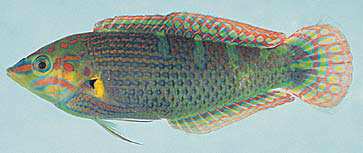| LABRIDAE |

Halichoeres vrolikii, 6.0 cm SL
(photo by Richard Winterbottom)
|
Halichoeres vrolikii (Bleeker, 1855) Vrolik's Wrasse |
|
D IX, 12; A III, 12; P1 13-14; LLp 26- 27; GR 19-21. Body slightly elongate. Dorsal profile of head convex; jaws prominent; a single pair of prominent canines situated anteriorly in each jaw; pharyngeal teeth well developed, molariform. Dorsal-fin origin above base of pectoral fins. Predorsal scales reaching to or slightly anterior to a vertical at posterior edge of eyes; rest of head naked. Lateral line complete. Caudal fin rounded; pelvic fins of males long, reaching origin of anal fin. Color: initial phase with alternating narrow dark-edged blue and yellow stripes which continue onto head; a vertically elongate dark spot immediately behind eye; a small blue-edged black spot on first interspinous membrane of dorsal fin, a large one above base on second and third soft rays, and another small one at upper base of caudal fin. Terminal males salmon pink dorsally, shading to light green on side and ventrally; base of exposed part of each scale with blue-edged green spot; four narrow green bars dorsally on posterior half of body; head and thorax with blue-edged salmon pink bands; a black triangular spot at upper pectoral base; rest of pectoral base broadly bright yellow; median fins salmon to orange with blue-edged green spots and bands. Size: maximum length about 13 cm. Distribution: Eastern Indian Ocean and West Pacific. Remarks: found on shallow protected reefs to about 20 m depth. |
|
|